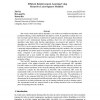582 search results - page 50 / 117 » Gaussian Processes in Reinforcement Learning |
IWANN
1999
Springer
15 years 2 months ago
1999
Springer
To avoid the curse of dimensionality, function approximators are used in reinforcement learning to learn value functions for individual states. In order to make better use of comp...
100
click to vote
NIPS
2007
14 years 11 months ago
2007
Bayesian Reinforcement Learning has generated substantial interest recently, as it provides an elegant solution to the exploration-exploitation trade-off in reinforcement learning...
NIPS
1996
14 years 11 months ago
1996
Dynamic Programming, Q-learning and other discrete Markov Decision Process solvers can be applied to continuous d-dimensional state-spaces by quantizing the state space into an arr...
108
click to vote
JAIR
2002
14 years 9 months ago
2002
The recursive least-squares (RLS) algorithm is one of the most well-known algorithms used in adaptive filtering, system identification and adaptive control. Its popularity is main...
NECO
2007
14 years 9 months ago
2007
Learning agents, whether natural or artificial, must update their internal parameters in order to improve their behavior over time. In reinforcement learning, this plasticity is ...

